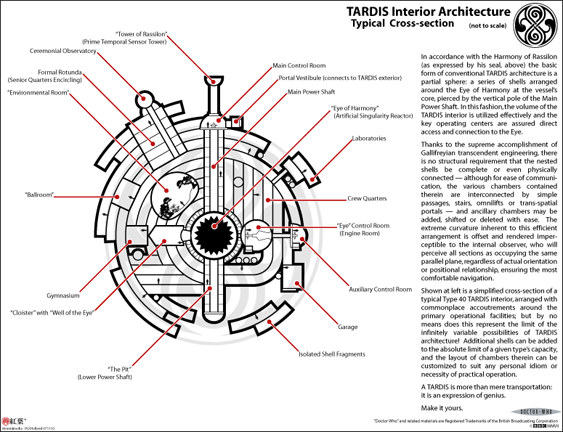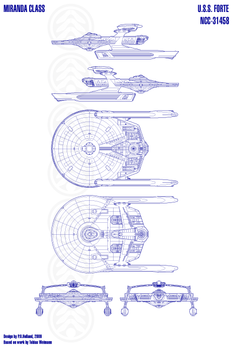HOME | DD
 Phaeton99 — ARCHER Class Schematic WIP
Phaeton99 — ARCHER Class Schematic WIP

Published: 2007-12-20 19:54:36 +0000 UTC; Views: 13573; Favourites: 78; Downloads: 666
Redirect to original
Description
Here is a glimpse of the ARCHER Project: the largely completed dorsal view. This is an original starship design, developed from a rough concept drafted in the early 1990s, intended to fit neatly into the setting era of Star Trek: The Next Generation.The ARCHER Class (named for Sagittarius, not the captain of NX-01; conceivably part of a "zodiac" series of small ship classes) is an Interdiction Escort, a type of vessel that patrols the space-lanes of the Federation in squadrons of six, engaging in inspection, traffic management, search rescue & repair, and shipping interdiction as an extension of the UFP Department of Commerce.
Developed in parallel with the "Next Generation" starships, the GALAXY and NEBULA Classes, the ARCHER shares the same design lineage, and thus many of the definitive characteristics, of its larger cousins. Shown here is the original configuration of the Class Ship, USS Archer, at the introduction of the new line circa 2355.
Incomplete schematics
ARCHER versus KELLER Class Interdiction Escort
Length: 294m
Breadth: 165m
Elevation: 54m
Crew Compliment: 180-260
Setting Background and Details:
To boldly tread the common paths, to guard and protect the travelers, and shine a light in the dark shadows all 'round...
The ARCHER is not a ship of exploration, nor science, nor shipping, nor defense against hostile intruders. It is a ship of the law. Operating in close conjunction with the Federation Bureau of Commerce, these vessels engage in an unglamorous yet essential role, monitoring interstellar trade routes and enforcing commerce law.
Although the primary role of the ARCHER Class to police Federation space and shipping does entail forcefully confronting belligerent smugglers and the occasional pirate on occasion, its most common operations are traffic control, inspection and "search and rescue". Pursuit, capture and combat are uncommon operations, but occur with some frequency even in the quietest of Federation space-lanes, and ARCHER crews must be prepared for the emergence of such necessity, or to be called upon at any time to support such engagements.
Traffic control is by far the most tedious and routine of ARCHER operations. This may be conducted from relatively stationary "check points" along a commerce channel or the vicinity of a traffic hub, or "on the run" from point to point, tracking and coordinating the flow along the length of a shipping lane.
Inspection of private and commercial vessels, the craft themselves as well as their cargos, passengers and personnel, is one of the many tasks ARCHER crews engage in on a daily basis. This often entails direct physical examination and assessment, rather than relying upon remote sensor readings alone, with boarding (and occasional confiscation or detention) common practice. These inspections may be the culmination of long investigations or the result of momentary detection or even random spot checks. Safety and health compliance; proper handling or conveyance of perishable or hazardous cargos; ship operation and configuration standards; personnel license and passenger checks: the typical inspection deals with the most mundane, but essential, aspects of space commerce. Naturally, these inspections also look for contraband, smuggling, stowaways, and other illegal activities.
Search and rescue situations occur without warning, but with high regularity, and ARCHER Class vessels are outfitted as "first responders" to distress calls, with high-capacity evacuation transporter equipment and extensive medical facilities — exceptional, both in size and capability, for a vessel of this scale. Although not common, some ARCHER Class ships have been specifically configured to closely support hospital and medical vessels.
The ARCHER Class also is capable of precise grappling, manipulation and large scale warp-towing of masses many times greater than its own: a capacity to tractor stricken or disabled vessels to port, clear debris, and even "capture" near-warp targets (a technique for preventing hostile or criminally suspect vessels from fleeing — ARCHERs have too little mass to effectively yank a ship out of full warp). It is not uncommon for multiple ARCHER Class ships to coordinate large tractor jobs, allowing for high warp velocities under tow-load, or more effective grappling or capture of massive targets.
ARCHER Class ships often travel in coordinated groups of three to six, in a spread-out formation well beyond optical sight of each other, but a few seconds away at warp.
The ARCHER is notable for its utilization of specialized torpedos designed specifically to swarm and disable a targeted vessel with a massive energy pulse, rather than cause direct structural or systemic damage. Though the class's reputation as a "gunslinger" is well-earned, the double-barreled launcher of an ARCHER weapons pod, rather than firing salvos of photon torpedos on a regular basis, is more often put to work dispensing constellations of sensor probes and relay buoys.
Unlike its predecessor, the KELLER Class, the ARCHER has good range at high warp and can persistently pursue even the most fleet and tireless fugitive.
ARCHERs carry a full compliment of shuttles, runabouts and inspection craft.
Some ARCHER Class ships are equipped with specialized mission pods (likewise mounted on the lower "keel" superstructure) rather than the more common weapons pod; and a small percentage have no pod of any kind.
ARCHER Class vessels are usually commanded by Commander or Lieutenant Commander-Grade officers, or even Chief Petty Officers, depending upon mission and mode of deployment.
The crew compliment includes a disproportionately high number of security officers compared to other Starfleet vessels, and may also include Inspection Specialists or other agents — medical, engineering, investigative, etcetera — assigned by the Bureau for specific mission profiles.
ARCHER Class ships have very little spare room below decks, crammed with engines and fuel, crew accommodations, detention cells, medical facilities, and large cargo and shuttle bays (the latter dominating the saucer's lower decks). Most of the ship operations duty stations are therefore located on Deck 1, many in the Main Bridge proper. This lends the command center a somewhat claustrophobic atmosphere, in contrast to the similar sized, yet spacious, GALAXY Class bridge.
Notably absent from the typical ARCHER Class bridge is a dedicated "Sciences" console. As these vessels seldom stray from the well-traveled byways of Federation space, and are not assigned scientific missions or personnel as a rule, they therefore are seldom outfitted with such specialized stations or equipment. Should the need arise, the role of "Sciences" can be managed from the Sensor Monitor, Tactical or other stations as the situation warrants.
ARCHER Class bridge modules can be categorized under three general types: monitor, dedicated to space traffic management; interceptor, configured for starbase/commerce-hub localized interdiction and rescue operations; and patrol, which is a blend of the other two, optimized for deep space operations. All ARCHER Class bridge modules are fully ejectable with a capacity for independent emergency operation under impulse (with no warp capacity) and planetary landing.
Although its design program began some years after the inception of the GALAXY Development Project, the smaller size and relative simplicity of the ARCHER Class allowed it to enter service ahead of the larger class.
"People see the similarities with the GALAXY Class in the hull form and the general lines, and presume that the ARCHER is as grand. But the truth is that these are just work-a-day vessels; unremarkable, mundane..."
"...one may never see a great ship like the GALAXY or NEBULA in their lifetime, even if one travels the space-lanes regularly; but travelers and merchantman will be quite familiar with the sight of the ARCHER at every port-of-call and in the spaces between."
"The ARCHERs are a comforting sight to legitimate merchantmen; and many a rogue Ferengi Daimon and Orion trader can attest to their effectiveness and fine holding cells."
"The ARCHER is a small ship, but pretty powerful for its size. Could it go toe-to-toe with a Klingon cruiser or Romulan Warbird? Hell no! A lone ARCHER would be reduced to space debris pretty damn quick. Even a single Bird-of-Prey or Ferengi Marauder would be a tough fight. The ARCHER isn't a warship. It's a police vessel at most... but ARCHERs always travel in packs, and that's a force to be reckoned with."
For more background information and ongoing project development (including deck plan work), check out my design thread at the Subspace Comms Network. www.subspace-comms.net/index.p…
Digital Illustration, Adobe illustrator.
Deck 1 Development
[The shuttle bay used to be aft of bridge island in the earliest version (see below). This was deleted in the refined version of the design in favor of the two large hatches on the underside of the saucer (visible in the old rough, but not yet added to the new), which also serve for cargo bay access.]
Alternative, low-nacelle version
_________
"Star Trek: The Next Generation" is a Registered Trademark of CBS Studios Inc
Related content
Comments: 12

Do you have an alternate class name? 'Archer' is already a TOS-era scout class, which a novel series revolves around.
That being said, it's good to see you designin' spaceframes again.
👍: 0 ⏩: 1

This is not a new concept, but a very, very old one, the schematics likewise. I simply have posted them to the DA gallery.
👍: 0 ⏩: 1

My general sentiment stands.
👍: 0 ⏩: 0

This almost has a design-relation to the "A" era Hornet class carrier with the part under the main saucer section that serves as main deflector dish. A very TNG 'feel' to it.
👍: 0 ⏩: 0

Fascinating Concept. I'd like to see this in paintings in perspective shots.
👍: 0 ⏩: 0

That looks a lot more interesting from the side view than I would have guessed from the top view alone. I think you should go for raised nacelles. Always go for raised nacelles!
👍: 0 ⏩: 0

love the archer class, and would love to know more about it. how big a crew would it carry? where is the shuttlebay?
👍: 0 ⏩: 1

I've updated the illustration description with more detail (and links) that should answer your questions.
👍: 0 ⏩: 0

First off, this is very clean and executed work, worthy of any Trek manual. now as far as scalability, it needs some research and improvement. If you take the bridge size and match it to the windows on the saucer section, the windows seem a little too big. As for what i assume are the escape pods, they to seem a little too big in comparison the escape pods on a standard galaxy Class saucer section. Now, i don't know the size of the ship in general, so again, I have to assume sizing based on the era of the Galaxy Class. otherwise, i do like the design of this ship very much.
👍: 0 ⏩: 1

The scale is actually rather heavily researched: this is a very small ship and the illustration is to correct scale. Unfortunately, the GALAXY-style features look huge on something this size. This was among the issues that stalled the project.
Experiments with SOVEREIGN-type features have been promising, in contrast.
But this does not address the problem with the period-specific detailing of the class ship shown here.... so it waits for a workable solution.
👍: 0 ⏩: 1

Ok, so now I understand it now. It has the look in some respects of the galaxy but scaled down. To me, the bridge though still looks rather small in comparision to the rest of the ship, unless of course you want really big windows on the saucer. It's your design ultimately, just observing and reporting.
👍: 0 ⏩: 0



























